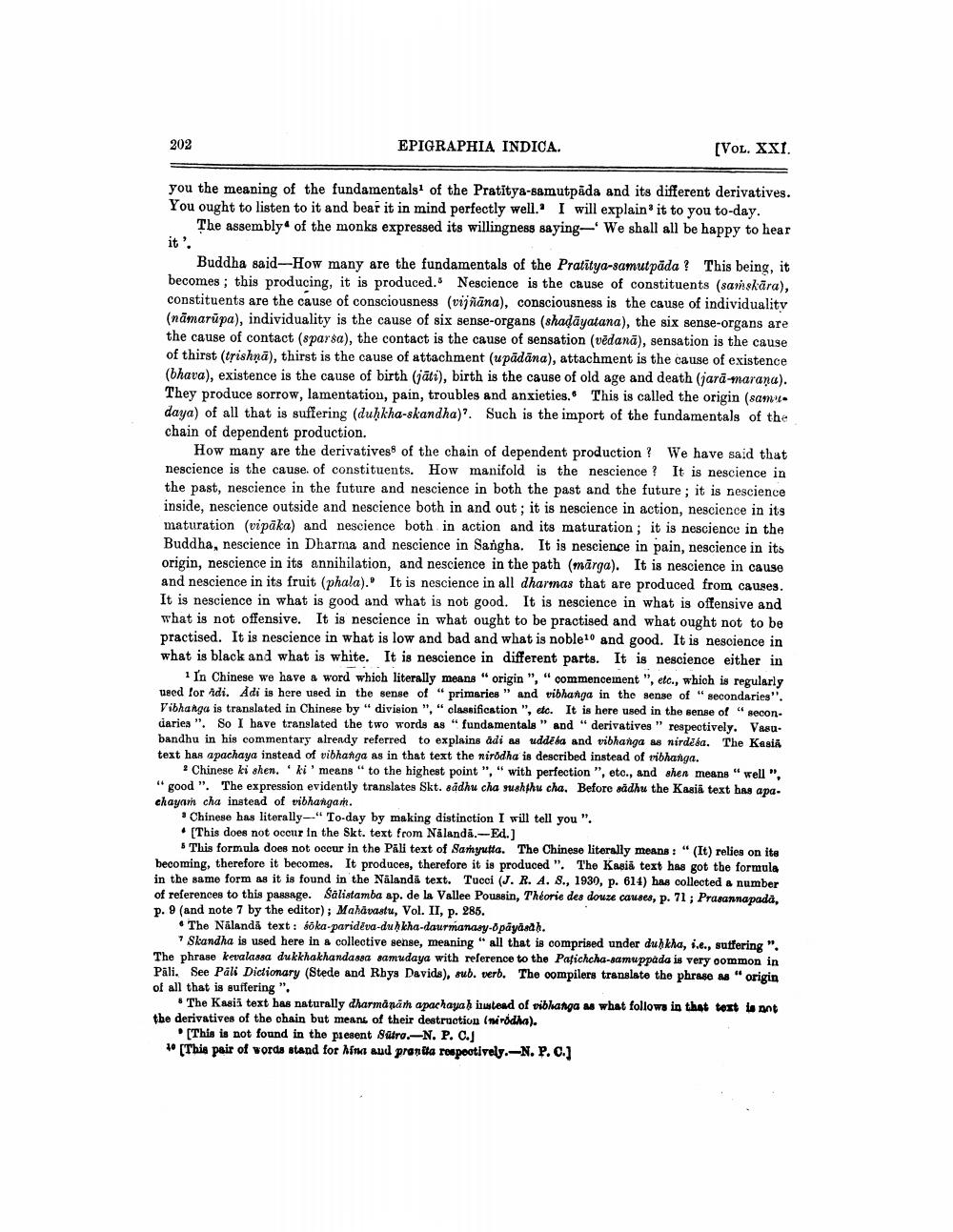________________
202
EPIGRAPHIA INDICA.
(VOL. XXI.
you the meaning of the fundamentals of the Pratītya-bamutpada and its different derivatives. You ought to listen to it and bear it in mind perfectly well. I will explain it to you to-day.
The assembly of the monks expressed its willingness saying-We shall all be happy to hear it.
Buddha said-How many are the fundamentals of the Pratitya-samutpāda ? This being, it becomes ; this producing, it is produced. Nescience is the cause of constituents (samskāra), constituents are the cause of consciousness (vijnana), consciousness is the cause of individuality (nāmarupa), individuality is the cause of six sense-organs (shadāyatana), the six sense-organs are the cause of contact (sparsa), the contact is the cause of sensation (vēdanā), sensation is the cause of thirst (trishņā), thirst is the cause of attachment (upādāna), attachment is the cause of existence (bhava), existence is the cause of birth (jāti), birth is the cause of old age and death (jara-marana). They produce sorrow, lamentation, pain, troubles and anxieties. This is called the origin (sam daya) of all that is suffering (duḥkha-skandha)? Such is the import of the fundamentals of the chain of dependent production.
How many are the derivatives of the chain of dependent production ? We have said that nescience is the cause of constituents. How manifold is the nescience? It is nescience in the past, nescience in the future and nescience in both the past and the future ; it is nescience inside, nescience outside and nescience both in and out; it is nescience in action, nescience in its maturation (vipäka) and nescience both in action and its maturation, it is nescience in the Buddha, nescience in Dharma and nescience in Sangha. It is nescience in pain, nescience in its origin, nescience in its annihilation, and nescience in the path (märga). It is nescience in cause and nescience in its fruit (phala). It is nescience in all dharmas that are produced from causes. It is nescience in what is good and what is not good. It is nescience in what is offensive and what is not offensive. It is nescience in what ought to be practised and what ought not to be practised. It is nescience in what is low and bad and what is noble10 and good. It is nescience in what is black and what is white. It is nescience in different parts. It is nescience either in
1 In Chinese we have a word which literally means "origin","commencement", etc., which is regularly need for adi. Adi is here used in the sense of "primaries" and vibhanga in the sense of " secondaries". Vibhanga is translated in Chinese by“ division", "classification ", ec. It is here used in the sense of " secon. daries ". So I have translated the two words as "fundamentals" and " derivatives " respectively. Vasubandhu in his commentary already referred to explains adi as uddela and vibhanga as nirdzka. The Kasia text has apachaya instead of vibhanga as in that text the nirodha is described instead of vibhanga.
* Chinese ki shen. 'ki' means “to the highest point ", " with perfection ", etc., and shen means " well ". "good". The expression evidently translates Skt. sadhu cha rushthu cha. Before sådhu the Kasia text has apa. chayam cha instead of vibhangan.
• Chinese has literally-" To-day by making distinction I will tell you ". • [This does not occur in the Skt. text from Nålanda.-Ed.)
This formula does not occur in the Pali text of Samyutta. The Chinese literally means: "(It) relies on its becoming, therefore it becomes. It produces, therefore it is produced ". The Kasia text has got the formula in the same form as it is found in the Nålanda text. Tucci (J. R. A. 8., 1930, p. 614) has collected a number of references to this passage. Salistamba ap. de la Vallee Poussin, Théorie des douze causes, p. 71 ; Prasannapada, p. 9 (and note 7 by the editor); Mahavastu, Vol. II, p. 285.
• The Nälands text: soka-paridēva-duh kha-daurmanasy-Opayasdh.
Skandha is used here in & collective sense, meaning "all that is comprised under duhkha, i.e., suffering ". The phrase kevalassa dukkhakhanda sa samudaya with reference to the Pafichcha-samuppada is very common in Páli. See Pali Dictionary (Stede and Rbys Davids), sub. verb. The compilers translate the phrase as "origin of all that is suffering ".
• The Kasii text has naturally dharmanamh apachaya imtead of vibhanga as what follows in that text lo ant the derivatives of the chain but means of their destruction (miódha).
[This is not found in the present Sutro.-N. P. C.J ** [This pair of words stand for hina sud prania rospectively.-N. P. 0.]




